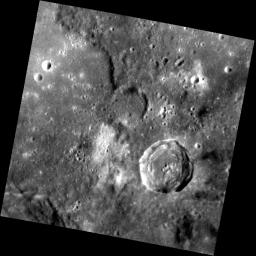This area, previously unseen during the Mariner 10 and MESSENGER flybys, was captured by MESSENGER's Narrow Angle Camera (NAC) in orbit. The view presents both contrasting albedo materials as well as contrasting terrain types. The image includes smooth plains along the left edge and a more rugged surface to the right. A 23-km-diameter impact crater sits between exposures of low reflectance material (LRM) to the east and patches of high albedo material to its west.
This image was acquired as part of MDIS's high-resolution surface morphology base map. The surface morphology base map will cover more than 90% of Mercury's surface with an average resolution of 250 meters/pixel (0.16 miles/pixel or 820 feet/pixel). Images acquired for the surface morphology base map typically have off-vertical Sun angles (i.e., high incidence angles) and visible shadows so as to reveal clearly the topographic form of geologic features.
The MESSENGER spacecraft is the first ever to orbit the planet Mercury, and the spacecraft's seven scientific instruments and radio science investigation are unraveling the history and evolution of the Solar System's innermost planet. Visit the Why Mercury? section of this website to learn more about the key science questions that the MESSENGER mission is addressing. During the one-year primary mission, MDIS is scheduled to acquire more than 75,000 images in support of MESSENGER's science goals.
Date acquired: July 13, 2011
Image Mission Elapsed Time (MET): 219009759
Image ID: 497191
Instrument: Narrow Angle Camera (NAC) of the Mercury Dual Imaging System (MDIS)
Center Latitude: 8.93°
Center Longitude: 91.56° E
Resolution: 180 meters/pixel
Scale: The large crater in this image is approximately 23 km (14 mi) in diameter.
Incidence Angle: 42.8°
Emission Angle: 3.0°
Phase Angle: 39.8°
These images are from MESSENGER, a NASA Discovery mission to conduct the first orbital study of the innermost planet, Mercury. For information regarding the use of images, see the MESSENGER image use policy.

 Planetary Data System
Planetary Data System












